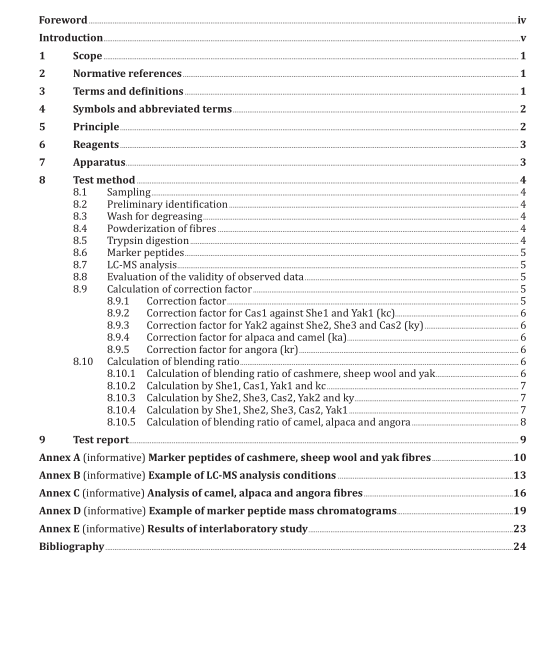EN ISO 20418-3:2020 pdf download.Textiles – Qualitative and quantitative proteomic analysis of some animal hair fibres – Part 3: Peptide detection using LC-MS without protein reduction (ISO 20418-3:2020)
8 Test method
8.1 Sampling
The general requirement is that the test specimen shall be representative for the lot of material from which it is taken. The method to obtain a fibre test specimen differs depending on the sample form. The terms relating to sampling for the various types of samples shall be in accordance with ISO 1833-1.
8.2 Preliminary identification
The preliminary qualitative analysis of the animal hair fibre shall be carried out based on their morphology, which is determined using light microscopy, according to ISO 17751 (all parts), after removal of non-animal fibre.
8.3 Wash for degreasing
8.3.1 Reflux 1 g of the fibres in a recovery flask (7.11) on a heating mantle (7.1) with 200 ml of acetone (6.1) for 30 min. This washing step may be omitted in the case of clean samples. Quantity of the fibres can be changed.
8.3.2 Take the degreased fibres out of the recovery flask and dry them in the air. Alternatively, the sample preparation method of ISO 20418-1 [5] can be used.
8.4 Powderization of fibres
Crush the dried fibre sample (8.3.2) using a mill (7.2) to get a fine powder with an average length of 100 µm or less by checking under the microscope and mix thoroughly for securing representative sampling of the fibres.
8.5 Trypsin digestion
8.5.1 Weigh about 10 mg of the crushed sample and place it into a microtube. If more than 10 mg of the sample is used, increase the volumes of the NH 4 HCO 3 solution in 8.5.2 and Trypsin solution in 8.5.3 proportionally.
8.5.2 Add 300 µl of the NH 4 HCO 3 solution (6.3) and vortex for 10 min to 30 min.
8.5.3 Add 10 µl of the Trypsin solution (6.7) to the sample and incubate at 37 °C for 20 h to 24 h.
8.5.4 Centrifuge the tryptic solution for 3 min using the centrifugal evaporator (7.6). Filter the supernatant through a membrane filter (7.3) to remove residual fibres.
NOTE Centrifugal filter, syringe filter or other means of filtration can be used.
8.5.5 Transfer the solution to an LC vial, then dry it using the centrifugal evaporator (7.6). If the LC vial does not fit in the dryer, the solution can be dried in other types of container such as a microtube. The sample is transferred to an LC vial after dissolution. Alternatively, a freeze dryer or nitrogen flux can be used as the drying method, instead of the centrifugal evaporator.
8.5.6 Add 40 µl of water containing 0,1 % formic acid and 5 % acetonitrile and vortex for 30 min, for subsequent LC-MS measurements. Sonication shall not be a substitute for vortex when LC-MS sample is dissolved.
8.6 Marker peptides
8.6.1 Select the peptides which are used as markers for differential identification of fibres, as specified in Annex A and Annex C. The result of the preliminary identification by microscopy (8.2) and Table 1 can be used as references for this selection.
8.6.2 Optimize LC-MS parameters and confirm retention times of target peaks by using either synthesized peptides (with amino acid sequences shown in Annex A and Annex C) or peptides extracted from pure animal hair fibre samples.
8.7 LC-MS analysis
8.7.1 Inject 5 µl of the sample onto an LC column (7.9). Use water containing 0,1 % formic acid and acetonitrile containing 0,1 % formic acid to form a gradient with increasing concentration of acetonitrile for chromatography. The initial concentration of acetonitrile is 5 %. An example of LC parameters is indicated in Annex B.
8.7.2 Operate mass spectrometer in SIM mode. The selected markers (preferably those with suffix 1), which are described in Annex A and Annex C, shall be monitored. An example of MS parameters is indicated in Annex B.
8.7.3 Integrate the peak area of each marker peptide. The peaks of additional marker peptides (those with suffix 2 and 3), which are also described in Annex A and Annex C, can be used when it is difficult to use the target peak.
8.8 Evaluation of the validity of observed data
See Annex C.
8.9 Calculation of correction factor.EN ISO 20418-3 pdf download.EN ISO 20418-3 pdf download
